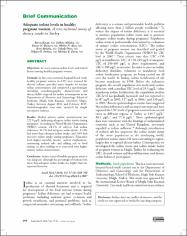Adequate iodine levels in healthy pregnant women. A cross-sectional survey of dietary intake in Turkey

View/
Date
2016Author
Kasap, BurcuAkbaba, Gülhan
Yeniçeri, Emine Neşe
Akın, Melike N.
Akbaba, Eren
Öner, Gökalp
Duru, Mehmet Emin
Metadata
Show full item recordAbstract
Objectives: To assess current iodine levels and related factors among healthy pregnant women. Methods: In this cross-sectional, hospital-based study, healthy pregnant women (n=135) were scanned for thyroid volume, provided urine samples for urinary iodine concentration and completed a questionnaire including sociodemographic characteristics and dietary habits targeted for iodine consumption at the Department of Obstetrics and Gynecology, School of Medicine, Mugla Sitki Kocman University, Mugla, Turkey, between August 2014 and February 2015. Sociodemographic data were analyzed by simple descriptive statistics. Results: Median urinary iodine concentration was 222.0 mu g/L, indicating adequate iodine intake during pregnancy. According to World Health Organization (WHO) criteria, 28.1% of subjects had iodine deficiency, 34.1% had adequate iodine intake, 34.8% had more than adequate iodine intake, and 3.0% had excessive iodine intake during pregnancy. Education level, higher monthly income, current employment, consuming iodized salt, and adding salt to food during, or after cooking were associated with higher urinary iodine concentration. Conclusion: Iodine status of healthy pregnant women was adequate, although the percentage of women with more than adequate iodine intake was higher than the reported literature.

















